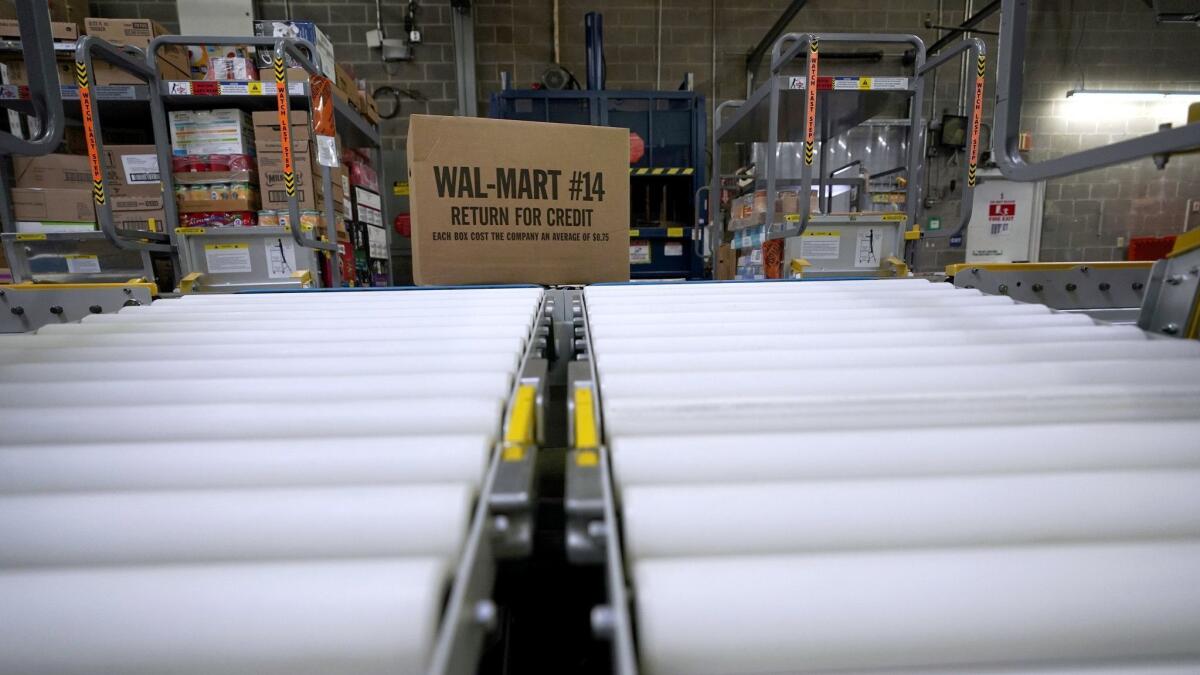Walmart offers next-day shipping, speeding deliveries as it battles Amazon

Walmart is rolling out free next-day delivery on its most popular items, increasing the stakes in the retail shipping wars with Amazon.com.
Walmart Inc., the nation’s largest retailer, said Tuesday that it has been building a network of more efficient e-commerce distribution centers to make that happen. The next-day service will cover 220,000 popular items including diapers, nonperishable food items, toys and electronics. That’s nearly double the number of items it carries in its stores.
Next-day delivery, which requires a minimum order of $35, became available in Phoenix and Las Vegas on Tuesday. In coming days, it will expand to Southern California. Walmart plans to roll out the service to three-quarters of the U.S. population by year’s end. It says it will add hundreds of thousands of products as the program expands.
The announcement comes two weeks after online behemoth Amazon.com Inc. said it’s upgrading its free shipping option to Prime members who pay $119 a year to one-day delivery, shortened from two-day delivery. Amazon has declined to say when the switch would happen, but it already offers one-day delivery for some items in certain areas.
Walmart said the new delivery program has been in the works for a while.
“Customer expectations continue to rise,” Marc Lore, chief executive of Walmart’s U.S. e-commerce division, said in a phone interview. “We’re trying to get ahead of that.”
The move will increase pressure on other rivals that are already investing millions of dollars to shorten the delivery window.
Amazon changed consumer expectations when it launched its two-day delivery for Prime members in 2005. But analysts say Amazon then needed to cut the delivery time in half to make its membership more attractive since other retailers such as Walmart offered free two-day deliveries without any membership required.
Two years ago, Walmart began offering free two-day shipping on millions of items on its website for orders of at least $35. Target also offers free two-day shipping for those who spend at least $35 or use its RedCard loyalty card. Walmart has also been expanding same-day grocery delivery service from its stores for a fee of about $10.
Lore said it will be cheaper for the company to do next-day delivery versus two-day service because eligible items will come from a single fulfillment center located closest to the customer. This means orders will ship in one box, or in as few boxes as possible, unlike two-day deliveries that come in multiple boxes from multiple locations. Walmart is also trying to limit costs by tailoring products based on what shoppers demand in the local markets. For example, sunscreen would be available all year for areas such as Southern California and Phoenix.
Still, Walmart sells far fewer products than Amazon, and its online sales are only a fraction of Amazon’s. Jason Goldberg, chief commerce strategy officer of Publicis Communications, said that Walmart won’t be able to ship the same number of products as Amazon under one-day shipping and that its profit margins could get further squeezed as it focuses on the most popular items, which would be subject to pricing wars.
Amazon has also been delivering more packages itself rather than relying on the post office or third-party carriers such as UPS and FedEx. The company expects to spend $800 million in the second quarter to speed up deliveries and has expanded its fleet of jets. On Monday, it announced that it would expand an incentive program to its employees to help them quit their jobs and start their own Amazon delivery businesses.
Walmart has one big advantage over Amazon: its more than 4,700 stores.
Walmart and Target have been turning their physical stores into shipping hubs, speeding up deliveries and helping to defray costs for such services as curbside delivery and in-store pickup. Walmart has also been expanding the use of robots in its stores, which keep tabs on what is and is not on the shelves. Meanwhile, Target has redesigned its staging area for packages to help speed up fulfillment of curbside deliveries.
More to Read
Inside the business of entertainment
The Wide Shot brings you news, analysis and insights on everything from streaming wars to production — and what it all means for the future.
You may occasionally receive promotional content from the Los Angeles Times.










